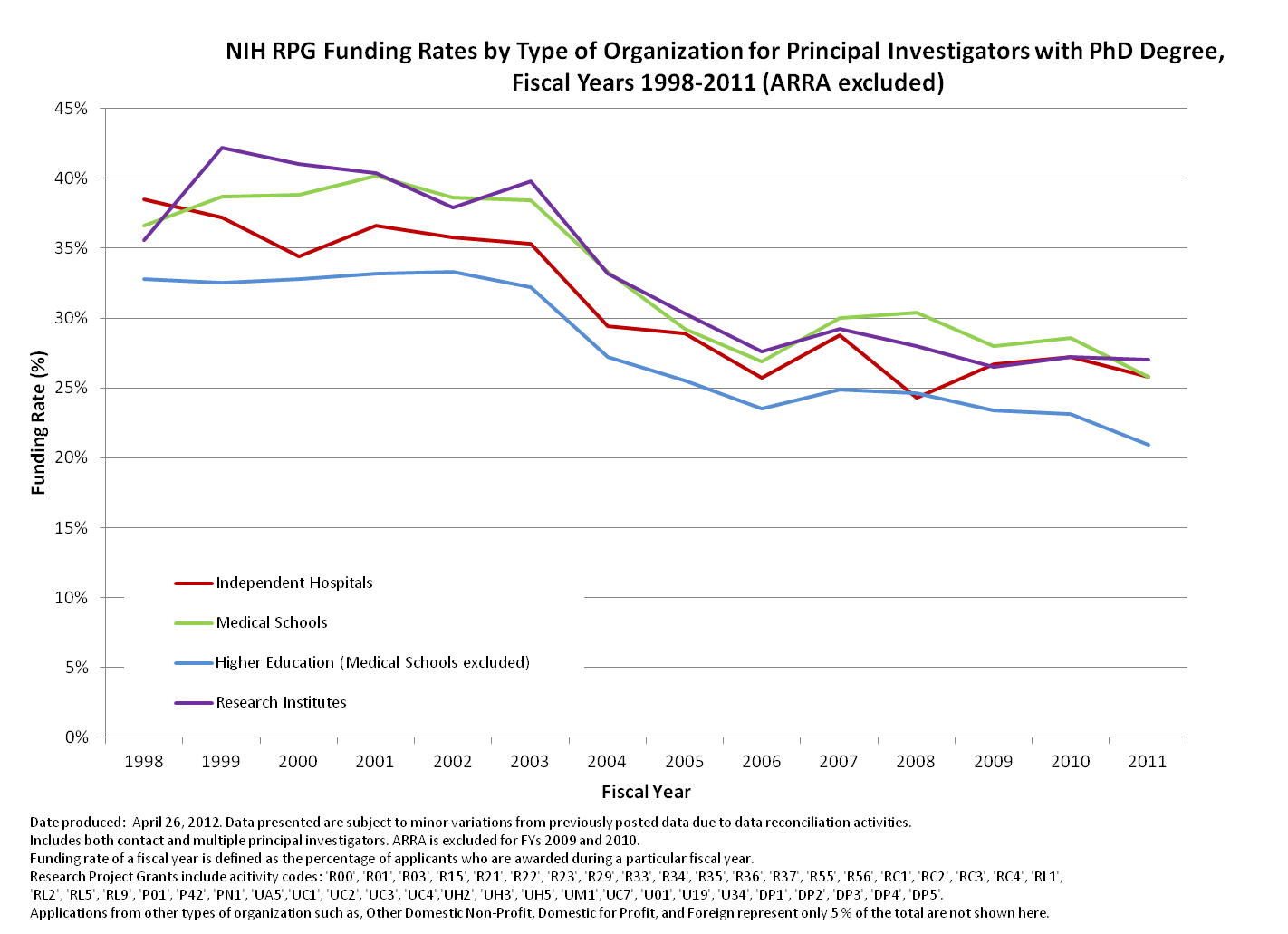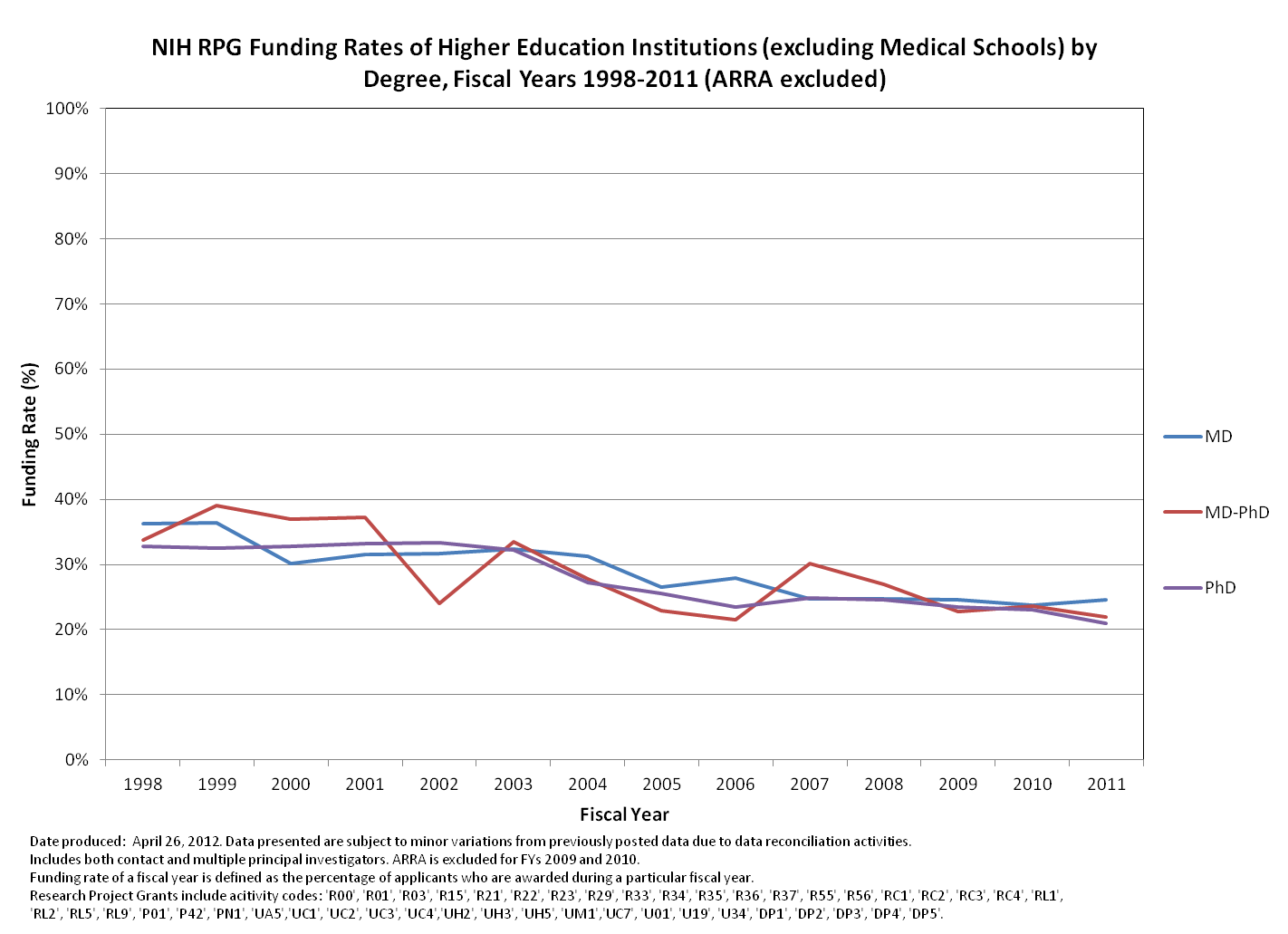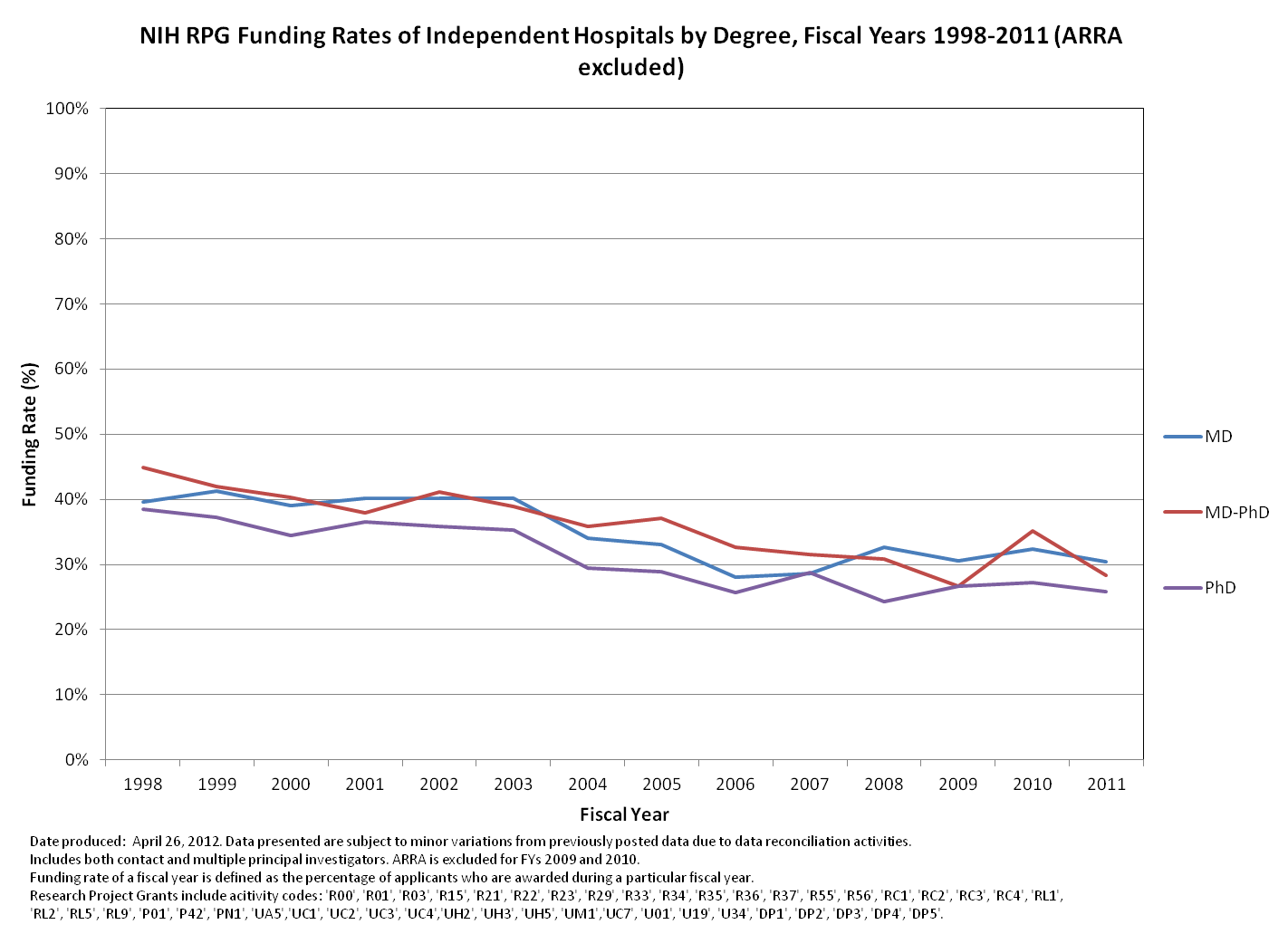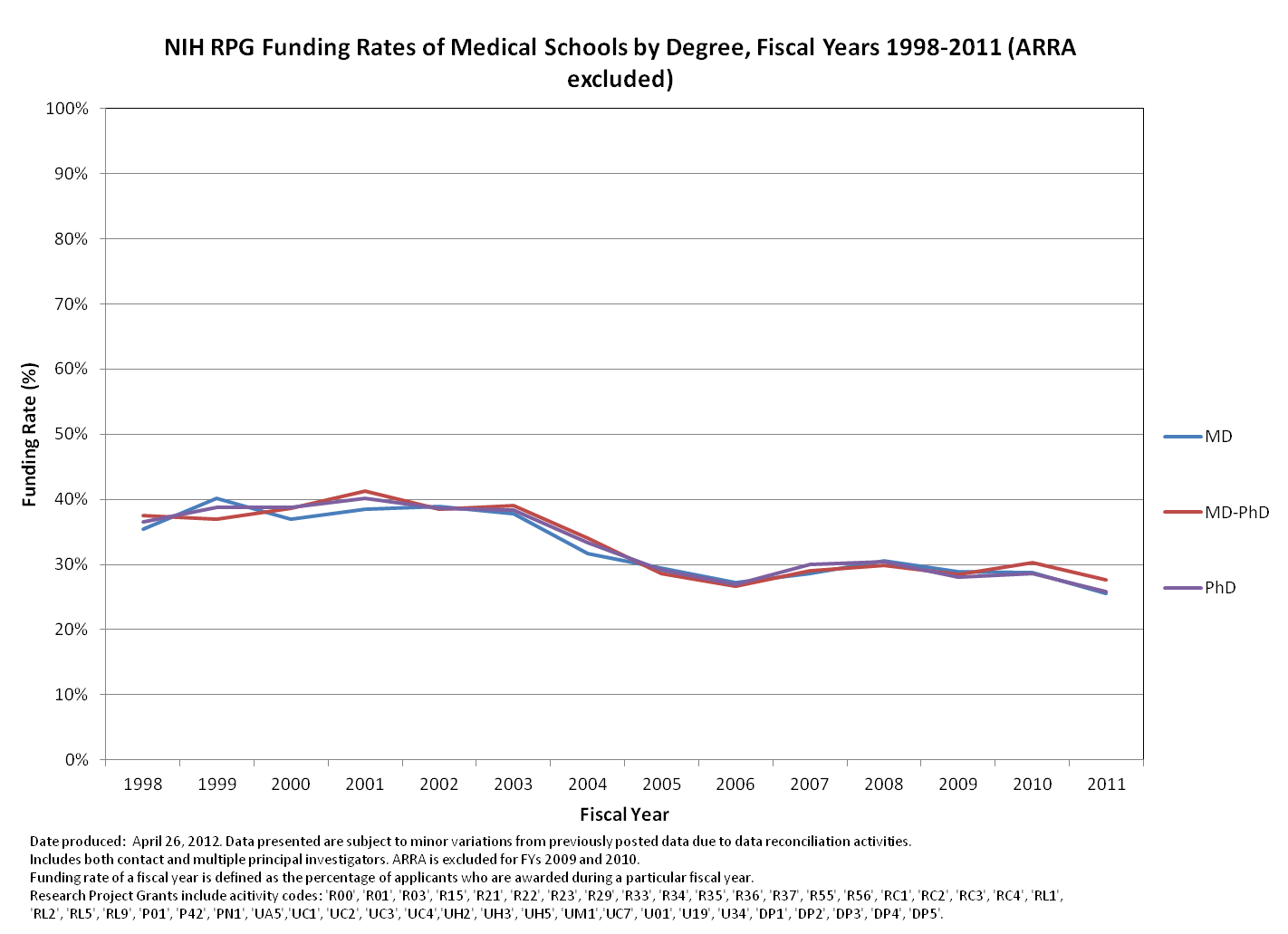Rock Talk Archives for May 2012
A Look at Funding Rates of PhDs at Different Institution Types
A few blogs ago, I provided information about investigators and different institution types. Let’s cut the data a couple additional ways. We’ve seen that investigators with a PhD tend to do slightly less well when competing for NIH funding. When you break out investigators by degree and the type of institution they work at, there isn’t really a big difference that pops out between those with an MD, PhD, or MD/PhD.
What if we compare the funding rate of investigators with a PhD from different institution types to each other? What you see is that investigators with a PhD at medical schools and research institutes fare better (by several percentage points) when compared to investigators with a PhD at institutions of higher education (not including medical schools).
If we look at funding rates broken out by type of organization, all investigators combined, we see a similar pattern. Overall, institutions of higher education (not including medical schools) have a lower funding rate when compared to independent hospitals, medical schools, and research institutes.
In the two graphs, there are differences in funding rates by institution, with higher education institutions having a lower funding rate, and there are differences by degree, with PhDs at a lower rate. Two weeks ago when we looked at rates by degree and institution type, we saw that, in general, PIs had the same funding rates regardless of degree type within each institution type. Medical schools had nearly identical rates for each degree type. So why do PhDs appear to have lower funding rates than other degree types? It is because they are most heavily concentrated in the institution type that fares least well—institutions of higher education (not including medical schools), see table 1 below. Remember, PhDs at medical schools do as well as MDs or MD/PhDs.
While these data are interesting, we have not tried to explain the cause of the differences as many institutional and situational factors contribute to PI funding rates. More food for thought.
| Fiscal Year | Organization | MD | MD/PhD | PhD | Total |
| Applicants(%) | Applicants(%) | Applicants(%) | Applicants(%) | ||
| 2011 | Higher Education excluding Medical Schools | 8.6% | 14.9% | 46.3% | 37.2% |
| 2011 | Independent Hospitals | 13.9% | 12.0% | 5.0% | 7.1% |
| 2011 | Medical Schools | 69.5% | 65.5% | 41.1% | 48.0% |
| 2011 | Research Institutes | 8.1% | 7.7% | 7.6% | 7.7% |
| 2011 Total | 100.0% | 100.0% | 100.0% | 100.0% |
Table 1. Percentage Distribution of NIH Research Project Applicants by Organization within a Degree Type
Notes: Research Project Grants in FY 2011 include activity codes: ‘R00′, ‘R01′, ‘R03′, ‘R15′, ‘R21′, ‘R22′, ‘R23′, ‘R29′, ‘R33′, ‘R34′, ‘R35′, ‘R36′, ‘R37′, ‘R55′, ‘R56′, ‘RC1′, ‘RC2′, ‘RC3′, ‘RC4′, ‘RL1′, ‘RL2′, ‘RL5′, ‘RL9′, ‘P01′, ‘P42′, ‘PN1′, ‘UA5′,’UC1′, ‘UC2′, ‘UC3′, ‘UC4′,’UH2′, ‘UH3′, ‘UH5′, ‘UM1′,’UC7′, ‘U01′, ‘U19′, ‘U34′, ‘DP1′, ‘DP2′, ‘DP3′, ‘DP4′, ‘DP5′
Excludes ARRA, Superfund, reimbursables
Applications from other types of organization such as, Other Domestic Non-Profit, Domestic for Profit, and Foreign, that represent only 5 % of the total, are not shown
Piloting the $1.5M Special Review
Back in February, I posted on our fiscal year 2013 Presidential budget request. One of the things I mentioned was an additional review that we were considering for applications from investigators that have received NIH funds of $1.5M or more in total costs. It has taken us some time to work through the details of how this additional review might be done. We recognized that if we ultimately make the decision to implement the policy in FY13, that we needed to pilot test draft procedures during the Advisory Council meetings this May.
Before getting into the details, I want to remind everyone of one of important point. This is not a cap on the total amount of funds an investigator can receive from NIH. It is a special review during Advisory Council deliberations to determine if additional funds should be provided to well-supported investigators. This pilot compliments existing NIH policies that requires us to monitor investigator’s activities for dual/overlapping support. We are asking the Advisory Councils to look at the full context of research project grant (RPG) support for these investigators and provide recommendations about how funding the pending application will distinctly advance research emanating from this lab. We are piloting these procedures now to gain feedback, which will help us to shape this special review, should we determine to fully implement it as a future policy.
Applications that will be given special review include:
New and renewal applications from investigators who currently receive more than $1.5M in total costs for research project grants.
This means the total of all your active RPG awards at the time the application goes to council. In other words, if you are in the second year of a 5-year R01 that was awarded for $1.5M, the $300K awarded this year will count, plus the current year awarded for any other active RPGs.
Applications excluded from special review include:
- Applications received in response to a request for applications
- P01s and other multi-component RPGs, unless all the investigators exceed the threshold
- Multi-PI applications, unless all the investigators exceed the threshold
To give you an idea of the scope, for applications going to May councils that fall within the top 25th percentile, we identified approximately 70 applications that fit the criteria above. Once we see how this process works at our upcoming council meetings, we will be able to provide additional information in the future.
You can read more in the Guide notice that we published today.
Does Your Institution Matter?
In one of my recent posts, I looked at the question of whether the degree you hold makes a difference in your likelihood of achieving funding. You can click the link above, but the answer was, “not really.” For example, in 2011, investigators with a PhD had a slightly lower funding rate (24%) compared to those with an MD (26%) or an MD/PhD (27%), and this pattern is relatively constant when we look back at the past decade.
I promised last time that I would look at the breakdown by institution type.
Interestingly, within a given type of institution, there are not significant, sustained differences between the groups, excluding, perhaps, independent hospitals. Medical schools, which as a group receive the greatest percentage of NIH funding, support investigators that are essentially indistinguishable when you look at their funding rates.
Exciting New Program
Imagine if you had a partnership with industry where you had access to compounds never before available to you, which you could use to test ideas for new therapeutics and identify promising new treatments. That’s the unique program that the NIH National Center for Advancing Translational Sciences just announced, Discovering New Therapeutic Uses for Existing Molecules. This is an opportunity to establish new research relationships between NIH, the academic community, and the private sector. NCATS has partnered with Pfizer Inc., AstraZeneca, and Eli Lilly, who have agreed to make 20 compounds available. These compounds have already gone through extensive research and development, perhaps for one disease; passed initial safety testing in humans; but, in the end, were not effective for that particular disease. Much like azidothymidine (AZT), which proved unsuccessful as a cancer drug but revolutionized HIV treatment, we hope that some of these molecules will be put to new therapeutic uses.
Through this new program, researchers will have access to these molecules and related data to use for pre-clinical and feasibility studies. To support the program, NCATS will provide up to $20M in research grants in fiscal year 2013. We ask for your input on this program and encourage you to reply to this request for information by June 1, 2012.
There is also a notice of intent to publish a request for applications, so you can start planning your application. This notice announces a somewhat unusual process for NIH. We will use a pre-application process to select the most meritorious projects, which will then be invited to submit a subsequent application for a cooperative agreement. Those applicants will have established an agreement with the company prior to submitting their follow-on application. In another revolutionary step to facilitate the partnership, we developed template agreements to help streamline the legal and administrative process for partnering with industry and managing intellectual property.
We expect the RFA to be published in May 2012, with the first application due date in mid-July 2012. This venture represents a ground-breaking partnership between pharmaceutical companies and the biomedical research community, a new way of doing business at NIH, and, most importantly, significant potential benefits for patients. I encourage you to have a look and provide comments.







